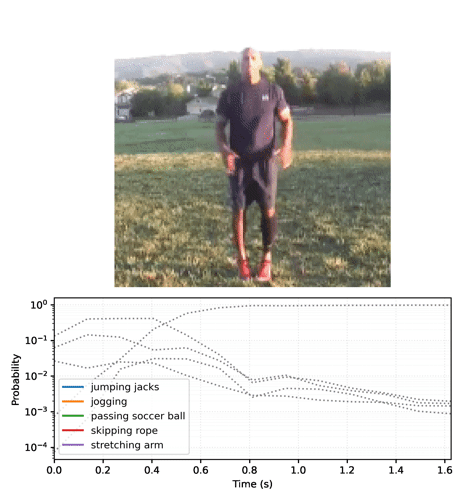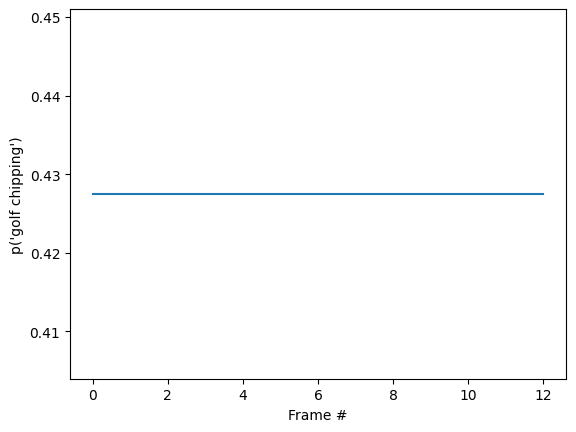 在 TensorFlow.org 上查看 在 TensorFlow.org 上查看
|
 在 Google Colab 中运行 在 Google Colab 中运行 |
 在 GitHub 上查看源代码 在 GitHub 上查看源代码 |
 下载笔记本 下载笔记本 |
 查看 TF Hub 模型 查看 TF Hub 模型
|
本教程运行预训练的视频分类模型来对给定视频中的活动(例如跳舞、游泳、骑自行车等)进行分类。
本教程中使用的模型架构称为 MoViNet(移动视频网络)。MoVieNet 是一系列在庞大数据集 (Kinetics 600) 上训练的高效视频分类模型。
与 TF Hub 上提供的 i3d 模型相比,MoViNet 还支持流式视频的逐帧推断。
预训练模型可从 TF Hub 获得。TF Hub 集合还包括为 TFLite 优化的量化模型。
这些模型的源代码可在 TensorFlow Model Garden 中找到。包括本教程的较长版本,较长版本还介绍了如何构建和微调 MoViNet 模型。

安装
对于较小模型 (A0-A2) 的推断,CPU 对于此 Colab 来说已经足够。
sudo apt install -y ffmpegpip install -q mediapy
pip uninstall -q -y opencv-python-headlesspip install -q "opencv-python-headless<4.3"
# Import libraries
import pathlib
import matplotlib as mpl
import matplotlib.pyplot as plt
import mediapy as media
import numpy as np
import PIL
import tensorflow as tf
import tensorflow_hub as hub
import tqdm
mpl.rcParams.update({
'font.size': 10,
})
2022-12-14 22:01:54.870835: W tensorflow/compiler/xla/stream_executor/platform/default/dso_loader.cc:64] Could not load dynamic library 'libnvinfer.so.7'; dlerror: libnvinfer.so.7: cannot open shared object file: No such file or directory 2022-12-14 22:01:54.870941: W tensorflow/compiler/xla/stream_executor/platform/default/dso_loader.cc:64] Could not load dynamic library 'libnvinfer_plugin.so.7'; dlerror: libnvinfer_plugin.so.7: cannot open shared object file: No such file or directory 2022-12-14 22:01:54.870971: W tensorflow/compiler/tf2tensorrt/utils/py_utils.cc:38] TF-TRT Warning: Cannot dlopen some TensorRT libraries. If you would like to use Nvidia GPU with TensorRT, please make sure the missing libraries mentioned above are installed properly.
获取 kinetics 600 标签列表,并打印前几个标签:
labels_path = tf.keras.utils.get_file(
fname='labels.txt',
origin='https://raw.githubusercontent.com/tensorflow/models/f8af2291cced43fc9f1d9b41ddbf772ae7b0d7d2/official/projects/movinet/files/kinetics_600_labels.txt'
)
labels_path = pathlib.Path(labels_path)
lines = labels_path.read_text().splitlines()
KINETICS_600_LABELS = np.array([line.strip() for line in lines])
KINETICS_600_LABELS[:20]
Downloading data from https://raw.githubusercontent.com/tensorflow/models/f8af2291cced43fc9f1d9b41ddbf772ae7b0d7d2/official/projects/movinet/files/kinetics_600_labels.txt
9209/9209 [==============================] - 0s 0us/step
array(['abseiling', 'acting in play', 'adjusting glasses', 'air drumming',
'alligator wrestling', 'answering questions', 'applauding',
'applying cream', 'archaeological excavation', 'archery',
'arguing', 'arm wrestling', 'arranging flowers',
'assembling bicycle', 'assembling computer',
'attending conference', 'auctioning', 'backflip (human)',
'baking cookies', 'bandaging'], dtype='<U49')
为了提供一个简单的示例视频进行分类,我们可以加载一个正在执行的跳跃运动的简短 gif。

出处:Bobby Bluford 教练根据 CC-BY 许可在 YouTube 上分享的视频。
下载 gif。
jumpingjack_url = 'https://github.com/tensorflow/models/raw/f8af2291cced43fc9f1d9b41ddbf772ae7b0d7d2/official/projects/movinet/files/jumpingjack.gif'
jumpingjack_path = tf.keras.utils.get_file(
fname='jumpingjack.gif',
origin=jumpingjack_url,
cache_dir='.', cache_subdir='.',
)
Downloading data from https://github.com/tensorflow/models/raw/f8af2291cced43fc9f1d9b41ddbf772ae7b0d7d2/official/projects/movinet/files/jumpingjack.gif 783318/783318 [==============================] - 0s 0us/step
定义一个将 gif 文件读入 tf.Tensor 的函数:
# Read and process a video
def load_gif(file_path, image_size=(224, 224)):
"""Loads a gif file into a TF tensor.
Use images resized to match what's expected by your model.
The model pages say the "A2" models expect 224 x 224 images at 5 fps
Args:
file_path: path to the location of a gif file.
image_size: a tuple of target size.
Returns:
a video of the gif file
"""
# Load a gif file, convert it to a TF tensor
raw = tf.io.read_file(file_path)
video = tf.io.decode_gif(raw)
# Resize the video
video = tf.image.resize(video, image_size)
# change dtype to a float32
# Hub models always want images normalized to [0,1]
# ref: https://tensorflow.google.cn/hub/common_signatures/images#input
video = tf.cast(video, tf.float32) / 255.
return video
视频的形状为 (frames, height, width, colors)
jumpingjack=load_gif(jumpingjack_path)
jumpingjack.shape
TensorShape([13, 224, 224, 3])
如何使用模型
本部分包含演示如何使用 TensorFlow Hub 中的模型的演练。如果您只想查看模型的实际运作,请跳至下一部分。
每个模型都有两个版本:base 和 streaming。
base版本将视频作为输入,并返回帧上的平均概率。streaming版本将视频帧和 RNN 状态作为输入,并返回该帧的预测和新的 RNN 状态。
基础模型
%%time
id = 'a2'
mode = 'base'
version = '3'
hub_url = f'https://tfhub.dev/tensorflow/movinet/{id}/{mode}/kinetics-600/classification/{version}'
model = hub.load(hub_url)
CPU times: user 14.9 s, sys: 628 ms, total: 15.5 s Wall time: 15.7 s
此版本的模型具有一个 signature。它接受一个 image 参数,此参数是一个形状为 (batch, frames, height, width, colors) 的 tf.float32。它返回包含一个输出的字典:一个由形状为 (batch, classes) 的 logit 组成的 tf.float32 张量。
sig = model.signatures['serving_default']
print(sig.pretty_printed_signature())
signature_wrapper(*, image)
Args:
image: float32 Tensor, shape=(None, None, None, None, 3)
Returns:
{'classifier_head': <1>}
<1>: float32 Tensor, shape=(None, 600)
要在视频上运行此签名,您需要先将外部 batch 维度添加到视频中。
#warmup
sig(image = jumpingjack[tf.newaxis, :1]);
%%time
logits = sig(image = jumpingjack[tf.newaxis, ...])
logits = logits['classifier_head'][0]
print(logits.shape)
print()
(600,) CPU times: user 4.03 s, sys: 33.9 ms, total: 4.07 s Wall time: 6.34 s
定义一个 get_top_k 函数,将上述输出处理打包以备后用。
# Get top_k labels and probabilities
def get_top_k(probs, k=5, label_map=KINETICS_600_LABELS):
"""Outputs the top k model labels and probabilities on the given video.
Args:
probs: probability tensor of shape (num_frames, num_classes) that represents
the probability of each class on each frame.
k: the number of top predictions to select.
label_map: a list of labels to map logit indices to label strings.
Returns:
a tuple of the top-k labels and probabilities.
"""
# Sort predictions to find top_k
top_predictions = tf.argsort(probs, axis=-1, direction='DESCENDING')[:k]
# collect the labels of top_k predictions
top_labels = tf.gather(label_map, top_predictions, axis=-1)
# decode lablels
top_labels = [label.decode('utf8') for label in top_labels.numpy()]
# top_k probabilities of the predictions
top_probs = tf.gather(probs, top_predictions, axis=-1).numpy()
return tuple(zip(top_labels, top_probs))
将 logits 转换为概率,并查找视频的前 5 个类。模型确认该视频可能是 jumping jacks。
probs = tf.nn.softmax(logits, axis=-1)
for label, p in get_top_k(probs):
print(f'{label:20s}: {p:.3f}')
jumping jacks : 0.834 zumba : 0.008 lunge : 0.003 doing aerobics : 0.003 polishing metal : 0.002
流式模型
上一部分使用了一个贯穿整个视频的模型。通常在处理视频时,您不希望在最后进行单次预测,而是希望逐帧更新预测。stream 版本的模型可让您实现此目的。
加载 stream 版本的模型。
%%time
id = 'a2'
mode = 'stream'
version = '3'
hub_url = f'https://tfhub.dev/tensorflow/movinet/{id}/{mode}/kinetics-600/classification/{version}'
model = hub.load(hub_url)
CPU times: user 43 s, sys: 2.22 s, total: 45.3 s Wall time: 45.2 s
此模型的用法比 base 模型略微复杂一些。您必须跟踪模型 RNN 的内部状态。
list(model.signatures.keys())
['call', 'init_states']
init_states 签名将视频的形状 (batch, frames, height, width, colors) 作为输入,并返回包含初始 RNN 状态的大型张量字典:
lines = model.signatures['init_states'].pretty_printed_signature().splitlines()
lines = lines[:10]
lines.append(' ...')
print('.\n'.join(lines))
signature_wrapper(*, input_shape).
Args:.
input_shape: int32 Tensor, shape=(5,).
Returns:.
{'state/b0/l0/pool_buffer': <1>, 'state/b0/l0/pool_frame_count': <2>, 'state/b0/l1/pool_buffer': <3>, 'state/b0/l1/pool_frame_count': <4>, 'state/b0/l1/stream_buffer': <5>, 'state/b0/l2/pool_buffer': <6>, 'state/b0/l2/pool_frame_count': <7>, 'state/b0/l2/stream_buffer': <8>, 'state/b1/l0/pool_buffer': <9>, 'state/b1/l0/pool_frame_count': <10>, 'state/b1/l0/stream_buffer': <11>, 'state/b1/l1/pool_buffer': <12>, 'state/b1/l1/pool_frame_count': <13>, 'state/b1/l1/stream_buffer': <14>, 'state/b1/l2/pool_buffer': <15>, 'state/b1/l2/pool_frame_count': <16>, 'state/b1/l2/stream_buffer': <17>, 'state/b1/l3/pool_buffer': <18>, 'state/b1/l3/pool_frame_count': <19>, 'state/b1/l3/stream_buffer': <20>, 'state/b1/l4/pool_buffer': <21>, 'state/b1/l4/pool_frame_count': <22>, 'state/b1/l4/stream_buffer': <23>, 'state/b2/l0/pool_buffer': <24>, 'state/b2/l0/pool_frame_count': <25>, 'state/b2/l0/stream_buffer': <26>, 'state/b2/l1/pool_buffer': <27>, 'state/b2/l1/pool_frame_count': <28>, 'state/b2/l1/stream_buffer': <29>, 'state/b2/l2/pool_buffer': <30>, 'state/b2/l2/pool_frame_count': <31>, 'state/b2/l2/stream_buffer': <32>, 'state/b2/l3/pool_buffer': <33>, 'state/b2/l3/pool_frame_count': <34>, 'state/b2/l3/stream_buffer': <35>, 'state/b2/l4/pool_buffer': <36>, 'state/b2/l4/pool_frame_count': <37>, 'state/b2/l4/stream_buffer': <38>, 'state/b3/l0/pool_buffer': <39>, 'state/b3/l0/pool_frame_count': <40>, 'state/b3/l0/stream_buffer': <41>, 'state/b3/l1/pool_buffer': <42>, 'state/b3/l1/pool_frame_count': <43>, 'state/b3/l1/stream_buffer': <44>, 'state/b3/l2/pool_buffer': <45>, 'state/b3/l2/pool_frame_count': <46>, 'state/b3/l2/stream_buffer': <47>, 'state/b3/l3/pool_buffer': <48>, 'state/b3/l3/pool_frame_count': <49>, 'state/b3/l3/stream_buffer': <50>, 'state/b3/l4/pool_buffer': <51>, 'state/b3/l4/pool_frame_count': <52>, 'state/b3/l5/pool_buffer': <53>, 'state/b3/l5/pool_frame_count': <54>, 'state/b3/l5/stream_buffer': <55>, 'state/b4/l0/pool_buffer': <56>, 'state/b4/l0/pool_frame_count': <57>, 'state/b4/l0/stream_buffer': <58>, 'state/b4/l1/pool_buffer': <59>, 'state/b4/l1/pool_frame_count': <60>, 'state/b4/l2/pool_buffer': <61>, 'state/b4/l2/pool_frame_count': <62>, 'state/b4/l3/pool_buffer': <63>, 'state/b4/l3/pool_frame_count': <64>, 'state/b4/l4/pool_buffer': <65>, 'state/b4/l4/pool_frame_count': <66>, 'state/b4/l5/pool_buffer': <67>, 'state/b4/l5/pool_frame_count': <68>, 'state/b4/l5/stream_buffer': <69>, 'state/b4/l6/pool_buffer': <70>, 'state/b4/l6/pool_frame_count': <71>, 'state/head/pool_buffer': <72>, 'state/head/pool_frame_count': <73>}.
<1>: float32 Tensor, shape=(None, 1, 1, 1, 40).
<2>: int32 Tensor, shape=(1,).
<3>: float32 Tensor, shape=(None, 1, 1, 1, 40).
<4>: int32 Tensor, shape=(1,).
<5>: float32 Tensor, shape=(None, 2, None, None, 40).
...
initial_state = model.init_states(jumpingjack[tf.newaxis, ...].shape)
type(initial_state)
dict
list(sorted(initial_state.keys()))[:5]
['state/b0/l0/pool_buffer', 'state/b0/l0/pool_frame_count', 'state/b0/l1/pool_buffer', 'state/b0/l1/pool_frame_count', 'state/b0/l1/stream_buffer']
获得 RNN 的初始状态后,您可以传递状态和视频帧作为输入(保持视频帧的 (batch, frames, height, width, colors) 形状)。该模型会返回一个 (logits, state) 对。
刚看到第一帧后,模型不相信视频是“跳跃运动”:
inputs = initial_state.copy()
# Add the batch axis, take the first frme, but keep the frame-axis.
inputs['image'] = jumpingjack[tf.newaxis, 0:1, ...]
# warmup
model(inputs);
logits, new_state = model(inputs)
logits = logits[0]
probs = tf.nn.softmax(logits, axis=-1)
for label, p in get_top_k(probs):
print(f'{label:20s}: {p:.3f}')
print()
golf chipping : 0.427 tackling : 0.134 lunge : 0.056 stretching arm : 0.053 passing american football (not in game): 0.039
如果您在循环中运行模型,并在每一帧中传递更新的状态,模型会迅速收敛到正确的结果:
%%time
state = initial_state.copy()
all_logits = []
for n in range(len(jumpingjack)):
inputs = state
inputs['image'] = jumpingjack[tf.newaxis, n:n+1, ...]
result, state = model(inputs)
all_logits.append(logits)
probabilities = tf.nn.softmax(all_logits, axis=-1)
CPU times: user 516 ms, sys: 17.5 ms, total: 533 ms Wall time: 473 ms
for label, p in get_top_k(probabilities[-1]):
print(f'{label:20s}: {p:.3f}')
golf chipping : 0.427 tackling : 0.134 lunge : 0.056 stretching arm : 0.053 passing american football (not in game): 0.039
id = tf.argmax(probabilities[-1])
plt.plot(probabilities[:, id])
plt.xlabel('Frame #')
plt.ylabel(f"p('{KINETICS_600_LABELS[id]}')");

您可能会注意到,最终概率比上一部分中运行 base 模型的确定性要高得多。base 模型返回帧上预测的平均值。
for label, p in get_top_k(tf.reduce_mean(probabilities, axis=0)):
print(f'{label:20s}: {p:.3f}')
golf chipping : 0.427 tackling : 0.134 lunge : 0.056 stretching arm : 0.053 passing american football (not in game): 0.039
让预测变成随时间变化的动画
上一部分详细介绍了如何使用这些模型。本部分在此基础上生成一些不错的推断动画。
下面的隐藏单元定义了本部分中使用的辅助函数。
# Get top_k labels and probabilities predicted using MoViNets streaming model
def get_top_k_streaming_labels(probs, k=5, label_map=KINETICS_600_LABELS):
"""Returns the top-k labels over an entire video sequence.
Args:
probs: probability tensor of shape (num_frames, num_classes) that represents
the probability of each class on each frame.
k: the number of top predictions to select.
label_map: a list of labels to map logit indices to label strings.
Returns:
a tuple of the top-k probabilities, labels, and logit indices
"""
top_categories_last = tf.argsort(probs, -1, 'DESCENDING')[-1, :1]
# Sort predictions to find top_k
categories = tf.argsort(probs, -1, 'DESCENDING')[:, :k]
categories = tf.reshape(categories, [-1])
counts = sorted([
(i.numpy(), tf.reduce_sum(tf.cast(categories == i, tf.int32)).numpy())
for i in tf.unique(categories)[0]
], key=lambda x: x[1], reverse=True)
top_probs_idx = tf.constant([i for i, _ in counts[:k]])
top_probs_idx = tf.concat([top_categories_last, top_probs_idx], 0)
# find unique indices of categories
top_probs_idx = tf.unique(top_probs_idx)[0][:k+1]
# top_k probabilities of the predictions
top_probs = tf.gather(probs, top_probs_idx, axis=-1)
top_probs = tf.transpose(top_probs, perm=(1, 0))
# collect the labels of top_k predictions
top_labels = tf.gather(label_map, top_probs_idx, axis=0)
# decode the top_k labels
top_labels = [label.decode('utf8') for label in top_labels.numpy()]
return top_probs, top_labels, top_probs_idx
# Plot top_k predictions at a given time step
def plot_streaming_top_preds_at_step(
top_probs,
top_labels,
step=None,
image=None,
legend_loc='lower left',
duration_seconds=10,
figure_height=500,
playhead_scale=0.8,
grid_alpha=0.3):
"""Generates a plot of the top video model predictions at a given time step.
Args:
top_probs: a tensor of shape (k, num_frames) representing the top-k
probabilities over all frames.
top_labels: a list of length k that represents the top-k label strings.
step: the current time step in the range [0, num_frames].
image: the image frame to display at the current time step.
legend_loc: the placement location of the legend.
duration_seconds: the total duration of the video.
figure_height: the output figure height.
playhead_scale: scale value for the playhead.
grid_alpha: alpha value for the gridlines.
Returns:
A tuple of the output numpy image, figure, and axes.
"""
# find number of top_k labels and frames in the video
num_labels, num_frames = top_probs.shape
if step is None:
step = num_frames
# Visualize frames and top_k probabilities of streaming video
fig = plt.figure(figsize=(6.5, 7), dpi=300)
gs = mpl.gridspec.GridSpec(8, 1)
ax2 = plt.subplot(gs[:-3, :])
ax = plt.subplot(gs[-3:, :])
# display the frame
if image is not None:
ax2.imshow(image, interpolation='nearest')
ax2.axis('off')
# x-axis (frame number)
preview_line_x = tf.linspace(0., duration_seconds, num_frames)
# y-axis (top_k probabilities)
preview_line_y = top_probs
line_x = preview_line_x[:step+1]
line_y = preview_line_y[:, :step+1]
for i in range(num_labels):
ax.plot(preview_line_x, preview_line_y[i], label=None, linewidth='1.5',
linestyle=':', color='gray')
ax.plot(line_x, line_y[i], label=top_labels[i], linewidth='2.0')
ax.grid(which='major', linestyle=':', linewidth='1.0', alpha=grid_alpha)
ax.grid(which='minor', linestyle=':', linewidth='0.5', alpha=grid_alpha)
min_height = tf.reduce_min(top_probs) * playhead_scale
max_height = tf.reduce_max(top_probs)
ax.vlines(preview_line_x[step], min_height, max_height, colors='red')
ax.scatter(preview_line_x[step], max_height, color='red')
ax.legend(loc=legend_loc)
plt.xlim(0, duration_seconds)
plt.ylabel('Probability')
plt.xlabel('Time (s)')
plt.yscale('log')
fig.tight_layout()
fig.canvas.draw()
data = np.frombuffer(fig.canvas.tostring_rgb(), dtype=np.uint8)
data = data.reshape(fig.canvas.get_width_height()[::-1] + (3,))
plt.close()
figure_width = int(figure_height * data.shape[1] / data.shape[0])
image = PIL.Image.fromarray(data).resize([figure_width, figure_height])
image = np.array(image)
return image
# Plotting top_k predictions from MoViNets streaming model
def plot_streaming_top_preds(
probs,
video,
top_k=5,
video_fps=25.,
figure_height=500,
use_progbar=True):
"""Generates a video plot of the top video model predictions.
Args:
probs: probability tensor of shape (num_frames, num_classes) that represents
the probability of each class on each frame.
video: the video to display in the plot.
top_k: the number of top predictions to select.
video_fps: the input video fps.
figure_fps: the output video fps.
figure_height: the height of the output video.
use_progbar: display a progress bar.
Returns:
A numpy array representing the output video.
"""
# select number of frames per second
video_fps = 8.
# select height of the image
figure_height = 500
# number of time steps of the given video
steps = video.shape[0]
# estimate duration of the video (in seconds)
duration = steps / video_fps
# estiamte top_k probabilities and corresponding labels
top_probs, top_labels, _ = get_top_k_streaming_labels(probs, k=top_k)
images = []
step_generator = tqdm.trange(steps) if use_progbar else range(steps)
for i in step_generator:
image = plot_streaming_top_preds_at_step(
top_probs=top_probs,
top_labels=top_labels,
step=i,
image=video[i],
duration_seconds=duration,
figure_height=figure_height,
)
images.append(image)
return np.array(images)
首先,在视频的帧上运行流式模型,然后收集 logit:
init_states = model.init_states(jumpingjack[tf.newaxis].shape)
# Insert your video clip here
video = jumpingjack
images = tf.split(video[tf.newaxis], video.shape[0], axis=1)
all_logits = []
# To run on a video, pass in one frame at a time
states = init_states
for image in tqdm.tqdm(images):
# predictions for each frame
logits, states = model({**states, 'image': image})
all_logits.append(logits)
# concatinating all the logits
logits = tf.concat(all_logits, 0)
# estimating probabilities
probs = tf.nn.softmax(logits, axis=-1)
100%|██████████| 13/13 [00:00<00:00, 27.49it/s]
final_probs = probs[-1]
print('Top_k predictions and their probablities\n')
for label, p in get_top_k(final_probs):
print(f'{label:20s}: {p:.3f}')
Top_k predictions and their probablities jumping jacks : 0.999 zumba : 0.000 doing aerobics : 0.000 dancing charleston : 0.000 slacklining : 0.000
将概率序列转换为视频:
# Generate a plot and output to a video tensor
plot_video = plot_streaming_top_preds(probs, video, video_fps=8.)
100%|██████████| 13/13 [00:07<00:00, 1.72it/s]
# For gif format, set codec='gif'
media.show_video(plot_video, fps=3)
资源
预训练模型可从 TF Hub 获得。TF Hub 集合还包括为 TFLite 优化的量化模型。
这些模型的源代码可在 TensorFlow Model Garden 中找到。包括本教程的较长版本,较长版本还介绍了如何构建和微调 MoViNet 模型。
